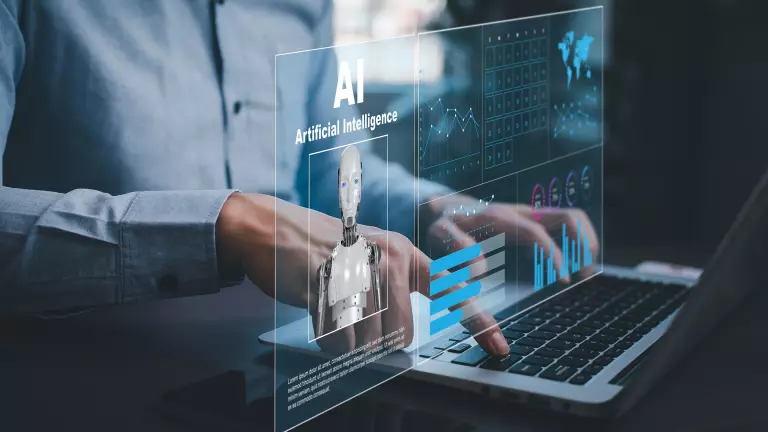Most consumers dislike chatbots—less than a third of online customers use them—and for good reason. Chatbots’ mechanical language lacks a personal touch, they rarely understand the consumer’s specific needs, and offer generic and vague information. There’s not much real conversation taking place in chatbots today. For actual advice, consumers turn to offline, human interactions, and physical channels, creating cost for the business and extra friction for consumers.
GenAI can transform online chat sessions into something more real—known as “conversational commerce”.
These clunky chatbots are likely to soon be a thing of the past. Generative AI (GenAI) can transform online chat sessions into something more real—known as “conversational commerce”—and give retailers an opportunity to use better online self-service to reduce the necessity for support by people. According to a recent BCG survey of 500 US consumers, 66% expressed strong interest in trying GenAI-powered conversational commerce, potentially doubling the use of this channel.
GenAI poses significant risks that companies must manage, including factual correctness, difficulty explaining results, data privacy, security, biased outputs, and copyright infringement. But handled correctly—such as by setting ethical principles, risk taxonomy, and tolerances—GenAI can provide a new model of conversational commerce that helps companies improve margins, boost revenue, and enhance the customer experience. To capitalize on the opportunity, companies need to create use cases that appeal to customers. They also need to plan for the broader transformation that GenAI will require, encompassing strategy, technology, people and processes, and governance.
Conversational Commerce in Action
Conversational commerce integrates human-like conversation, rich content, and personalized recommendations into the shopping experience, bringing together consumers and brands in every language. The transactional efficiency includes everything from simple product inquiries to complex purchases across multiple brands in a single interaction.
Imagine booking a trip—car, flight, hotel, restaurants and more—in a single interaction. Or completely furnishing a new apartment while managing cost or personal preferences. Digital interactions will become more intricate, intuitive, and personal, and offer consumers immediate and relevant responses, heretofore only provided by human advisors. For companies, adopting conversational commerce is crucial not only to meet evolving consumer expectations, but also to maintain a competitive edge in the digital age.
Conversational commerce powered by GenAI guides users throughout the typical eCommerce funnel from discovery to conversion (see Exhibit 1). Customers can initiate their shopping exploration with tools ranging from basic product listings to advanced data driven suggestions. In the comparison phase, customers are supported in making an informed decision through product comparisons supplemented with up-to-date inventory data. Finally, in the conversion stage customers are able to seamlessly transact while being presented with strategic upselling opportunities. While these experiences will initially appear across companies’ own websites, the future monetization of third-party Large Language Models will also unlock a new era of digital advertising that we call Chat Engine Optimization and Chat Engine Marketing.
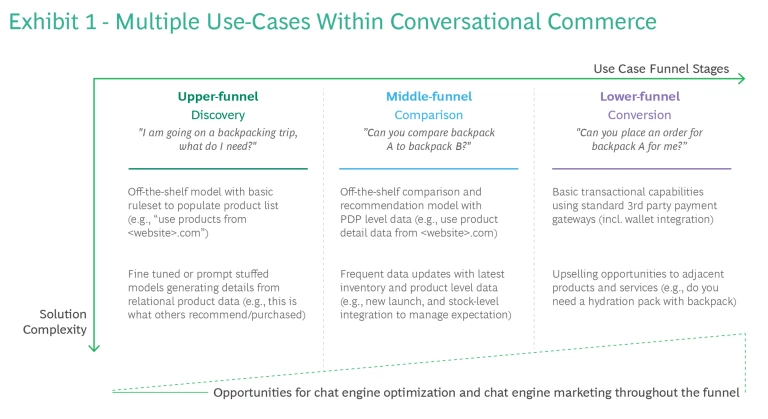
The Promise of Gen AI
The shortcomings of today’s chat experiences have resulted in low consumer adoption across most product categories. There are many friction points in conversational commerce, and a third of consumers simply don’t trust it. As a result, just 34% of consumers have used a chat experience to either learn about or purchase a product, and only 10% of customers have ever used it to actually complete a purchase (see Exhibit 2).
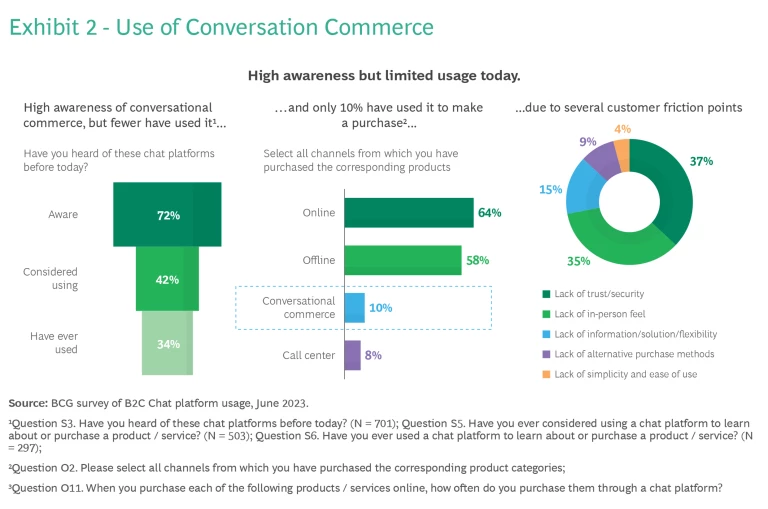
GenAI will be a secular change for chatbots and will provide a competitive advantage for those companies that adopt it. Indeed, GenAI promises enormous changes across all aspects of e-commerce, but it’s potential for conversational commerce is especially potent due to its natural language and data integration abilities (see Exhibit 3). While these capabilities are nascent today, in the near future best in class GenAI chat experiences will integrate:
- Human-like, proactive, and interactive conversations
- Robust understanding of customer needs
- Most transaction functions
- Multilanguage bots
- Broadly supported customer experience
- Key vendor partners and other third parties
- Optimized chat engines and chat engine marketing akin to SEO/SEM
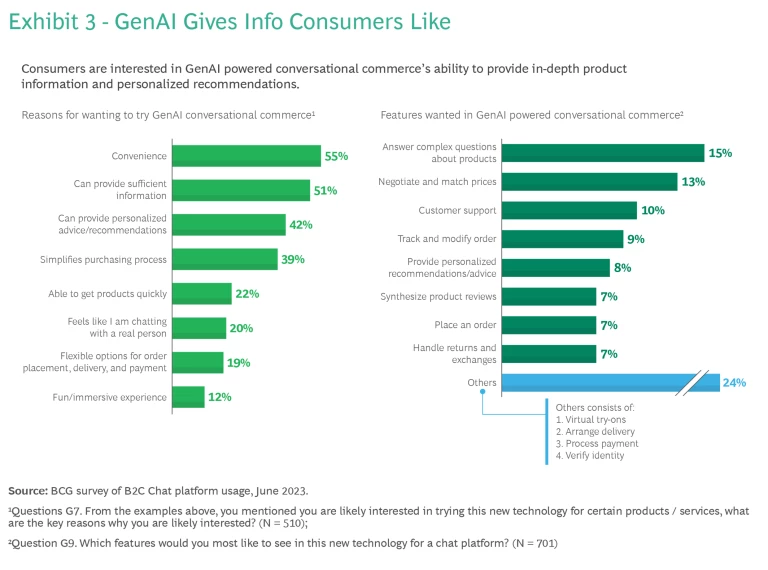
Early Adopters See Benefits
Although we are in the early days of GenAI (ChatGPT reached widespread awareness only in 2021), the opportunities are not theoretical. We have seen that GenAI-powered conversational commerce can reduce customer service costs by about 30%. With more personalized customer experience, digital marketing and sales are more efficient and pull in more revenue. Sales are running at a pace four times that of traditional conversational commerce. Customers are also happier, with satisfaction scores improving dramatically
Several companies are already moving quickly to explore the possibilities of GenAI-powered conversational commerce and are reaping rewards.
Several companies are already moving quickly to explore the possibilities of GenAI-powered conversational commerce and are reaping rewards.
- Walmart: Integrated OpenAI’s GPT-4 into its voice order and Text to Shop so customers can search for items, order them, and schedule a pickup or delivery. This new capability could provide human-like and interactive answers to customers throughout the entire buying journey.
- Google: Introduced a virtual “try-on” feature so customers can see how clothes will look on them before purchasing. Then a GenAI chatbot suggests different items from many different retailers.
- Expedia: Partnered with ChatGPT to release the first version of a chatbot for travel planning. Customers receive personalized recommendations and automatic intelligent shopping as they plan their vacations.
Harnessing Consumer Enthusiasm
For retailers looking to follow the example of the early adopters and capture these benefits, BCG’s research shows consumers are very willing to try GenAI-powered conversational commerce (even though their experiences with traditional chatbots have disappointed). Though this is due in part to the general enthusiasm and interest in all things AI, we think it also reveals a strong desire by consumers to conduct business as much as possible via digital channels.
Consumers show strong desire to conduct business via digital channels.
Our survey found interest in GenAI-powered conversational commerce to be two to three times higher than the current use of traditional conversational commerce (see Exhibit 4). This spans all product categories, with the greatest interest, not surprisingly, where advice before purchasing is most frequently needed.
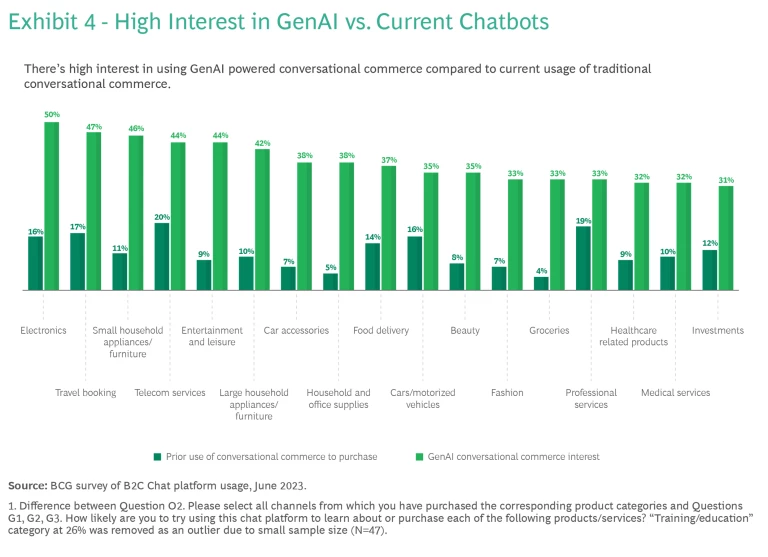
For companies to make the most of this, it’s crucial to base their first conversational commerce use cases on deep understanding of the specific needs and customer journeys in their respective industries. While use cases today center around the company’s own website, we expect that in the near future GenAI-powered conversational commerce will expand by integrating with a larger ecosystem of third parties. This will make conversational commerce even more powerful.
With so much riding on the design of strong use cases, we experimented with several to learn how effectively GenAI-powered conversational commerce can engage consumers. In Exhibit 5 we demonstrate the experience for a customer early in the discovery process. In Exhibit 6 we experiment with an end-to-end transaction experience, which creates opportunities for upselling.
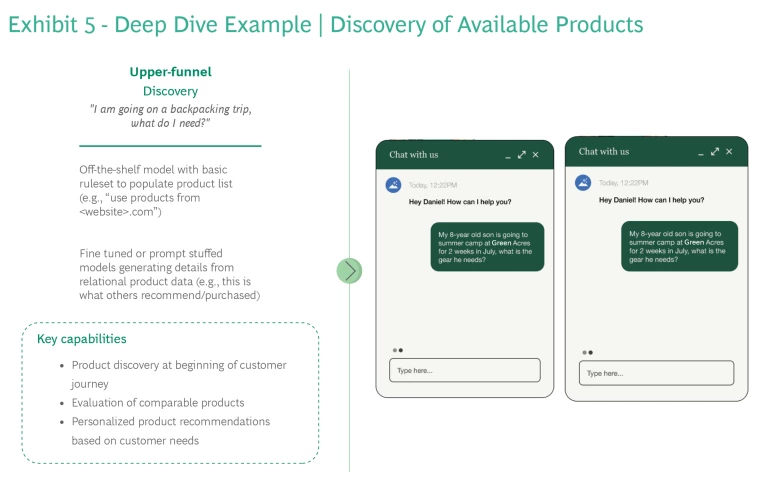
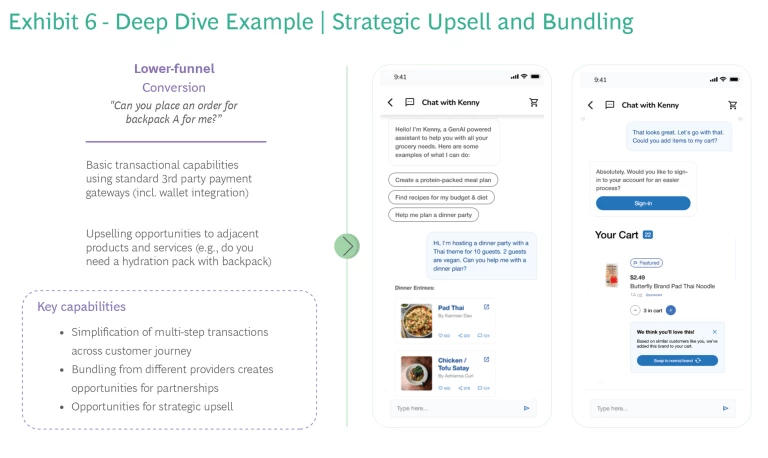
Consumer engagement with these use cases in the survey was very encouraging, indicating a consumer adoption rate for GenAI-powered conversational commerce of nearly 40 percentage points. Based on that enthusiasm, we expect that companies across product categories will increase their adoption of the technology by 26 percentage points. For some products, such as small household appliances and entertainment, business adoption could rise 35 percentage points. (see Exhibit 7).
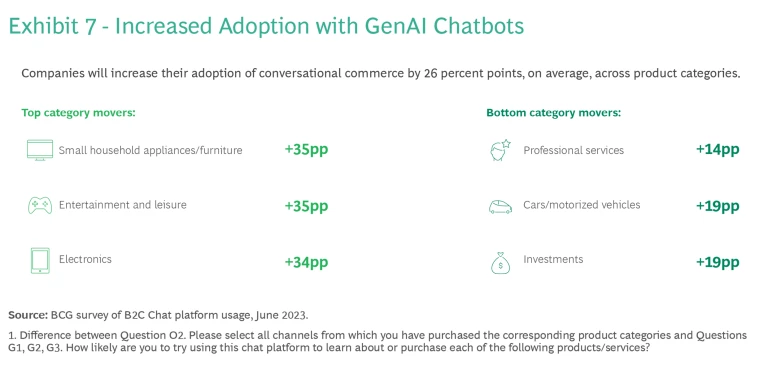
How to Prepare for GenAI
GenAI’s mainstream usage is recent, dating back only to 2021. There are still many unknowns and complexities companies must grapple with as they integrate GenAI-powered conversational commerce into their strategy and daily ways of working. Data and technology issues will obviously be crucial to this transition, but so too will employee and process changes.
Companies must grapple with many unknowns and complexities as they integrate GenAI-powered conversational commerce.
Strategy: The first and most important step is for leaders to set the tone at the top, embracing GenAI and articulating the benefits for the business, employees and customers. To put the strategy on solid footing, leaders need to identify and prioritize use cases based on customer needs. Because GenAI is evolving rapidly, leaders also need to plan for future capabilities not just the current ones. Their strategic roadmap should include investing in a data foundation that will underpin GenAI models, developing partnerships and adapting their business models.
Technology: The technology landscape is complex, with many players vying for a place in the emerging industry. Companies will need to conduct build vs. buy vs. partner analyses to determine the best way to roll out GenAI-powered conversational commerce. How much expertise does the company have in house? What are vendors’ real capabilities? Which vendors can build custom solutions, and which can just operate off-the-shelf solutions?
As part of the technology integration, companies will need to evaluate language models, platform and tools, customization, ecosystems and integration, and availability. After that evaluation, they will need to prepare additional corporate data and plug in live data feeds, create the initial ruleset, engage in Reinforcement Learning from Human Feedback (RLHF), integrate into front ends, and finally monitor and manage the pilot.
People and Processes: To unlock value, organizations should be bold in re-thinking processes, even re-imagining whole functions. Solid change management will be critical as the organization evolves its operating model, identifies skill gaps, hires and trains employees to fill those gaps, and assigns new roles.
For many employees, the adjustments won’t be minor. As companies adopt GenAI-powered conversational commerce, employees will spend less time doing manual, specialized work; instead, they will be trained to manage and interact with technologies designed to provide business insights. They will participate in more cross-functional teaming, enhanced evaluative thinking, and expedited decision making. In other words, their roles will become more strategic and value-adding, and new roles will emerge (such as a Chief AI Officer)
Governance: GenAI poses significant risks that companies must manage, including factual correctness, difficulty explaining results, data privacy, security, biased outputs, and copyright infringement. A “Responsible AI” framework starts by setting ethical principles, risk taxonomy, and tolerance. Then leaders must put a governance structure in place to oversee key processes, technology and tools, and the culture. The intent of Responsible AI is to deploy AI systems in a way that aligns with a company’s purpose and values while also delivering transformative business impact.
GenAI is ushering in enormous change for conversational commerce. For consumers this will be a welcome upgrade from today’s unintelligent chatbots. Companies also have much to gain in terms of better efficiencies, margins, revenue, and customer service. Adapting to GenAI will undoubtedly take time and effort, touch many parts of the organization, and change long-established ways of working. But according to our survey results, the competitive rewards will be significant.
